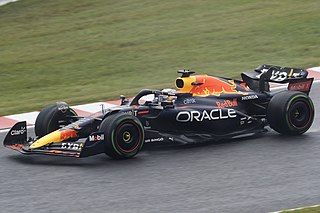
Motorsport, motorsports or autosports is a global term used to encompass the group of competitive sporting events which primarily involve the use of motorized vehicles. The terminology can also be used to describe forms of competition of two-wheeled motorised vehicles under the banner of motorcycle racing, and includes off-road racing such as motocross.
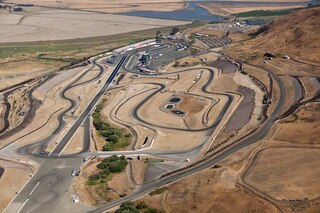
Sonoma Raceway is a road course and dragstrip located at Sears Point in the southern Sonoma Mountains of Sonoma County, California. The road course features 12 turns on a hilly course with 160 ft (49 m) of total elevation change. It is host to one of the few NASCAR Cup Series races each year that are run on road courses. It has also played host to the IndyCar Series, the NHRA Camping World Drag Racing Series, and several other auto races and motorcycle races such as the American Federation of Motorcyclists series. Sonoma Raceway continues to host amateur, or club racing events with some open to the public. The largest such car club is the Sports Car Club of America. The track is 30 mi (48 km) north of San Francisco and Oakland.
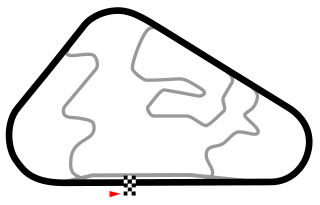
Pocono Raceway, also known as The Tricky Triangle, is a superspeedway located in the Pocono Mountains in Long Pond, Pennsylvania. It is the site of three NASCAR national series races and an ARCA Menards Series event in July: a NASCAR Cup Series race with support events by the NASCAR Xfinity Series and NASCAR Craftsman Truck Series. From 1971 to 1989, and from 2013 to 2019, the track also hosted an Indy Car race, currently sanctioned by the IndyCar Series. Additionally, from 1982 to 2021, it hosted two NASCAR Cup Series races, with the traditional first date being removed for 2022.

Laser tag is a recreational shooting sport where participants use infrared-emitting light guns to tag designated targets. Infrared-sensitive signaling devices are commonly worn by each player to register hits and are sometimes integrated within the arena in which the game is played.

Phoenix Raceway is a 1-mile, low-banked tri-oval race track located in Avondale, Arizona, near Phoenix. The motorsport track opened in 1964 and currently hosts two NASCAR race weekends annually including the final championship race since 2020. Phoenix Raceway has also hosted the CART, IndyCar Series, USAC and the WeatherTech SportsCar Championship. The raceway is currently owned and operated by NASCAR.

The 1984 Dallas Grand Prix was a Formula One motor race held on July 8, 1984 at Fair Park in Dallas, Texas. It was the only running of the Dallas Grand Prix as a Formula One race, and the ninth race of the 1984 Formula One World Championship.

Sebring International Raceway is a road course auto racing facility in the southeastern United States, located near Sebring, Florida.

Chicagoland Speedway is a 1.5 miles (2.4 km) tri-oval speedway with a curved backstretch in Joliet, Illinois, southwest of Chicago. The speedway opened in 2001 and actively hosted NASCAR racing including the NASCAR Cup Series until 2019. Until 2010, the speedway has also hosted the IndyCar Series, recording numerous close finishes including the closest finish in IndyCar history. The speedway is owned and operated by NASCAR.

World Wide Technology Raceway is a motorsport racing facility in Madison, Illinois, just east of St. Louis, close to the Gateway Arch. It features a 1.250 mi (2.012 km) oval that hosts the NASCAR Cup Series, NASCAR Craftsman Truck Series, and the NTT IndyCar Series, a 2.000 mi (3.219 km) infield road course used by SpeedTour TransAm, SCCA, and Porsche Club of America, a quarter-mile NHRA-sanctioned drag strip that hosts the annual NHRA Camping World Drag Racing Series Midwest Nationals event, and the Kartplex, a state-of-the-art karting facility.

Roberto José Guerrero Isaza is a Colombian-American former race driver. He participated in 29 Formula One Grands Prix, debuting on 23 January 1982, becoming the first Colombian to start a Formula One Grand Prix.
PJ1 TrackBite is a custom formulated synthetic resin, typically black in color, used in drag racing to either increase the traction of a car's tires or as a sealer for newly ground and/or resurfaced race tracks. It stays sticky for weeks, has fire-retardant properties, and is hydrophobic. It has been used in professional racing since 1972.
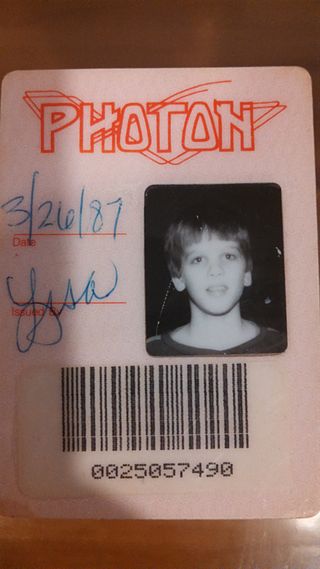
Photon was the name of the first commercial lasertag arenas. The company also came out with a home lasertag game, and there were various media tie-ins: a TV show also called Photon and a series of novels by Peter David.
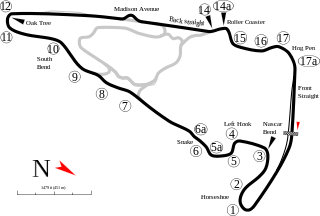
Virginia International Raceway (VIR) is a race track located in Alton, Virginia, near Danville. It is less than a half-mile from the North Carolina/Virginia border just outside Milton, North Carolina, on the banks of the Dan River. VIR hosts amateur and professional automobile and motorcycle events, driving schools, club days, and private test rentals.

The NASCAR Whelen Modified Tour (NWMT) is a modified stock car racing series owned and operated by NASCAR in the Modified Division. The Modified Division is NASCAR's oldest division, and is the only open-wheeled division that NASCAR sanctions. NASCAR Whelen Modified Tour events are mainly held in the northeastern United States, but the 2007 and 2008 tours expanded to the Midwest with the addition of a race in Mansfield, Ohio. The tour races primarily on short oval paved tracks, but the NWMT also has made appearances at larger ovals and road courses.

Calder Park Raceway is a motor racing circuit in Melbourne, Victoria, Australia. The complex includes a dragstrip, a road circuit with several possible configurations, and the "Thunderdome", a high-speed banked oval equipped to race either clockwise or anti-clockwise.
The National Association for Stock Car Auto Racing (NASCAR) is the sanctioning body for the NASCAR Cup Series, the Xfinity Series and the Craftsman Truck Series. NASCAR also administers a number of regional racing series, including the Whelen Modified Tour, and the Whelen All-American Series, as well as international series in Canada, Mexico, and Europe.
Heidelberg Raceway was an American auto racing track which was built near Heidelberg, Pennsylvania in Scott Township, Allegheny County, approximately 6 miles (9.7 km) southwest of Pittsburgh, Pennsylvania. It held weekly races and numerous special events between 1948 and 1973. It held four NASCAR Strictly Stock/Grand National Series and one NASCAR Convertible Division race between the 1940s and 1960s. In 1960, Heidelberg became the first track to fall off NASCAR's tour. The land is now occupied by a shopping center called Raceway Plaza.
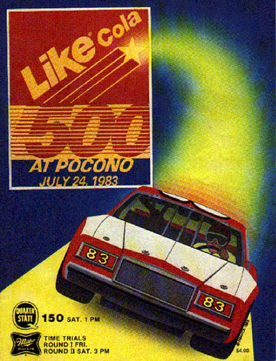

The Stadium Super Trucks (SST), formerly known as Speed Energy Formula Off-Road, is an American short course off-road racing series created by off-road racer and former IndyCar and NASCAR driver Robby Gordon in 2013. Sanctioned by the United States Auto Club (USAC) in America with title sponsorship from Gordon's Speed Energy brand, the series utilizes identical off-road trucks that originally competed primarily in American football stadiums, but in 2014 began racing mostly on street circuits and road courses, often in conjunction with the IndyCar Series race schedules.

The state of Indiana is home to two major professional sport franchises, and a number of college sports teams. Indiana is also prominent in auto racing.

















